[ad_1]
He is 50. It’s a reality check that you and I — we are all getting old. But he doesn’t feel so. Just a few days before he celebrates a landmark birthday, Sachin Tendulkar sits down at his bungalow in Mumbai for a chat and looks back at his first innings and spells out the targets for his second.
The chroniclers have often compared Sachin Tendulkar’s rise in international cricket with India’s changing face globally. How do you look at the parallel?
Coincidentally, the timing was such. Multiple changes were happening in our country at that time, and things started looking different. The biggest change I noticed on the field was the 1996 World Cup. From then on, things started changing dramatically in Indian cricket.
As a nation, of course, things were changing too. So many things happened around us. Even for me personally, actions that I was involved in started changing. There were sponsorships and multiple other things. I was possibly the first (Indian) cricketer to have signed a contract where an agent was managing an athlete. Otherwise, that concept didn’t exist in India until then.
There were a few statements about it from certain sectors saying now the focus is on money and all that. But, in fact, it was the other way around. I didn’t want to sit across the table negotiating contracts because that was never my strength. I didn’t want to waste my energy on that. What gave me a peaceful sleep at night was the right column on the scoreboard and whether the team won. That determined the quality of sleep I got.
The bank balance was never more important than the score account, so my family members would ask me more about the runs I scored than the contracts I signed. So, I wanted to be focussed only on the game.
How did you never let the middle-class inferiority complex affect you? It was synonymous with the Indian psyche in the 80s and the 90s…
I think it’s because of the calmness of my father along with the grit of my mother. I have always believed that niceness should not be taken as weakness. If I am nice, polite and humble, it doesn’t mean that I am not confident. I am just displaying my upbringing.
To me, I would say I was representing the nation on the field and my family everywhere else. That was important. Where I needed to show aggression, I showed aggression. There was a question once about my nature of being aggressive on the field and calm off it. I said: ‘On the field, I was reacting to what I saw, and off the field, I was responding to what was happening’.
There is a difference between reaction and response. Reaction came instinctively on the field where I knew I had to win the battle against the bowler and eventually against the team. Otherwise, the response was completely different. It has to do with my family. Most of the time, I would think how my father would have responded to a certain situation. That is what I do.
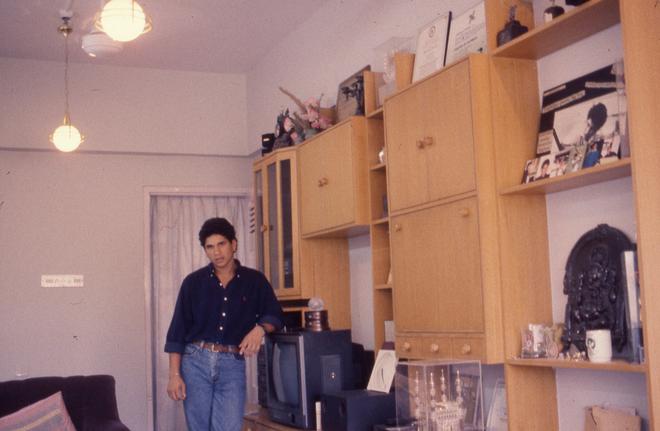
Sachin has always credited his middle class upbringing as the reason behind his dedication to cricket.
| Photo Credit: The Hindu Photo Library
How have you ensured that the bubbly kid in Sahitya Sahawas never let the Bharat Ratna or the global celebrity status supersede him?
The accolades are a reflection of what I have done in the field. But that doesn’t give me the right to misbehave or do whatever I want because at the end of the day I have to come back home and face everyone (in the family). It’ a reflection of the way the family — my parents, both my brothers and sister — brought me up. And, in the second part of my life, Anjali, her parents, my kids, uncles and my aunts — everyone around me played a big role.
We never really had celebrations for any of my achievements. Everyone was really happy, encouraging, and supportive of whatever I wanted to be, but there were never any big celebrations or parties. We just told ourselves, ‘This is a good moment, thank God’, offered a box of sweets and moved on. We always followed a mantra at home: “Let the whole world talk about the last match; we think about the next match”. That mantra started right in my schooldays.
Even when I did well in school matches, I felt good about it, but celebrations, as such, never happened. Let’s think about the next one. That way, the ball kept rolling, and also, it didn’t give me time to think about what I have been able to achieve and start thinking otherwise. The mind was constantly occupied with “What’s next?”. That process continues even now. So, just simple upbringing kept me grounded. Once I entered through the main door of the house, everything was normal. It didn’t matter what had happened on the field.
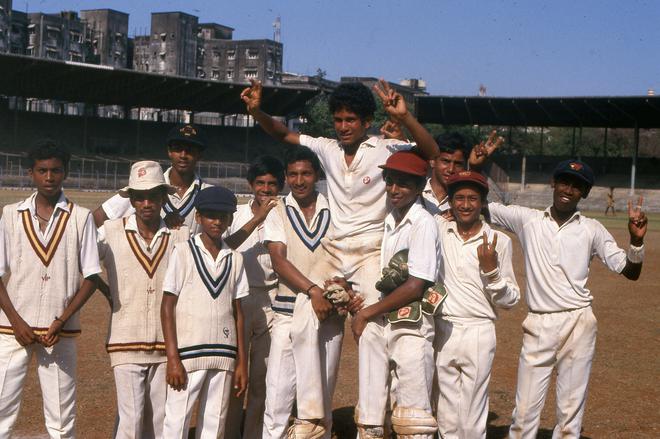
Sachin Tendulkar is the toast of his teammates, after he, alongside Vinod Kambli (extreme right), set the then world record for the unfinished third-wicket partnership of 664 runs in the inter-school Harris Shield semifinals against St. Xavier’s at the Azad Maidan ground in Bombay on February 27, 1988.
| Photo Credit: The Hindu Photo Library
Do you feel that there is now more focus on how Indian cricketers respond to certain things rather than how they play?
I think when one is representing the nation — India for me — it’s a package deal. What happens with a player on the field and around it becomes really important. Whether it’s a reaction or a response, it has to be measured. Like I said, if you are loud and vocal, it doesn’t make you any bigger or smaller than what you are. Whatever you are, is what you do on the field. And off the field, I have always believed that in my life, while I make runs or take wickets, the rest will take care of itself. The day it becomes reversed, it’s the beginning of your downfall.
It has been almost a decade since you last played for India. What is it that you miss the most about playing cricket?
When you are playing for your country, the pride, on-field challenges, meetings, dressing room camaraderie, and all other moments are natural but not permanent. These are the things that happen when you are with a team. We played a couple of tournaments here recently for Road Safety and it was fun to get together and play again.
Otherwise, my send-off was really good in the last match. I always used to think about how the experience of my last match would be like. Whatever happened on that day, it’s more than special to me. That’s the reason I don’t miss anything because that’s the last memory of me exiting the field as an active cricketer.
When they (West Indies) were eight-down, then nine-down, I was literally telling myself — ‘these are the last moments for me on the field. I was literally counting. And then, it would never be the same. I would never be an active India cricketer; would always be considered as a retired cricketer’. That moment was so special that I don’t have any regrets.
What is it that actually went on in your head while listening to the chant of of ‘Saaaachin, Saaaachin’ every time you walked out to bat?
There were occasions when I went in to bat I would tie my shoelaces if someone jumped on top of the sight screen. That was just to let the crowd settle down.
A batter or a bowler, whoever it may be, eventually has to own that space. And to own the space, you need to be in control. Occasionally, I would let them settle down first and then start playing, but it was difficult. The first few balls, there was excitement and all that. I would also sometimes feel different. Not all outings are the same. Sometimes you are in a good space, sometimes you aren’t. Sometimes, you are so focused that it really doesn’t matter; even when the screen is not right, you play. And sometimes you are not thinking right, you just need to buy some time to settle down. That’s where, at times, I used to take some time for myself and let the crowd settle down as well.
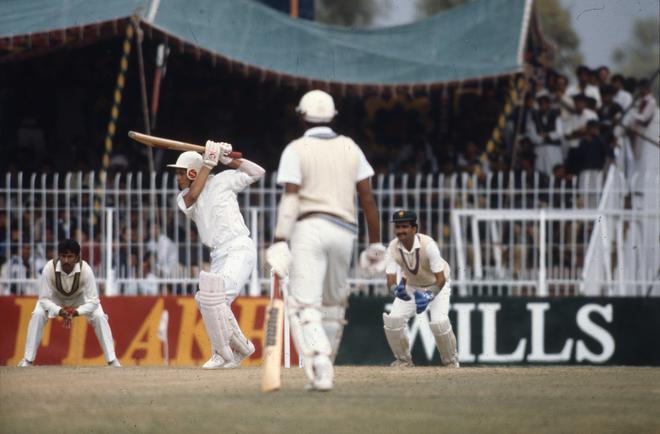
Sachin Tendulkar scored his maiden Test 50 in the second Test match between India and Pakistan in Faisalabad in November 1989.
| Photo Credit: The Hindu Photo Library
Do you remember the first time you ever heard that chant?
Yes, from my mother. She would keep calling out for me from the balcony — “Sachin, Sachin” — because I would never come back home on time. I would be playing with my friends, and she would endlessly keep calling. But I would ignore her because I wanted to keep playing. Evening time would be the most frustrating for me because I had to leave everyone and go home. Invariably, I used to be the last one to go back.
You were a trendsetter on the field in many ways — be it in technique, running between the wickets, playing lofted strokes consistently, et al. What do you make of modern batting techniques?
I think it has changed completely; and what’s changed it completely are the laws of the game. They keep changing and that is going to change the way one plays cricket too. You can make the game faster by adding more fielders in the circle. Or you can make it slower by reducing the number of players in the circle. The number of bouncers you use or the number of balls you use, these factors can make the game faster or slower.
If we shorten the game — say, make it 40 overs with an additional fielder in the circle — we’ll get to see maybe 380-run totals. Whereas if you take one fielder out of the circle and use just one ball, you may not see 300-plus totals so frequently.
It is all about the rules that the ICC introduces and also the kind of surfaces that we play on. Earlier, the matches would start at 9 am. In the first 45 minutes, the ball would swing, and the red ball would reverse as well and get soft. In the afternoons, the pitch would break up a bit thanks to the sun, thus helping the spinners. It was more balanced, I would say.
Up front, the pacers were in the game and later on the spinners also had a role. Now, from afternoon onwards, life has become, without any doubt, tougher for bowlers. There is no hiding there.
Would you want parity to be restored on the skills front rather than game to be driven more by the commercial aspect?
That balance has to be there. Of course, commercially, it has to make sense, but at the same time, if you are going to introduce shorter and faster formats for the younger generation, then we need to get the game going at a reasonable pace, even in Test cricket. It cannot be a dead track and a drawn Test match. Nobody wants to see that today.
It may sound slightly strange, but today’s generation possibly will not have the patience to watch a Test match for five days. I am not suggesting keeping limited-overs for each side, but it all depends on the kind of surfaces you produce. The surfaces have to be interesting enough — while in shorter formats they are tilted more towards batters, Test cricket can be tilted more towards bowlers.
It’s the bowler who is constantly asking questions to a batter. If that question itself is not interesting for spectators to watch, and if the bowler doesn’t get enough help from the surface, then the match becomes boring. It becomes too slow because other formats are way faster than this. On a flat surface, a bowler says, ‘Nothing is happening, I am going to play a defensive line’. A batter is thinking, ‘If I don’t play foolishly, I am okay. The bowler is not looking to get me out’.
In return, we are slowly but surely emptying the stadiums or not engaging enough eyeballs. To engage more eyeballs, I think the pitch has to be interesting enough and helpful enough for a bowler to do something every over.
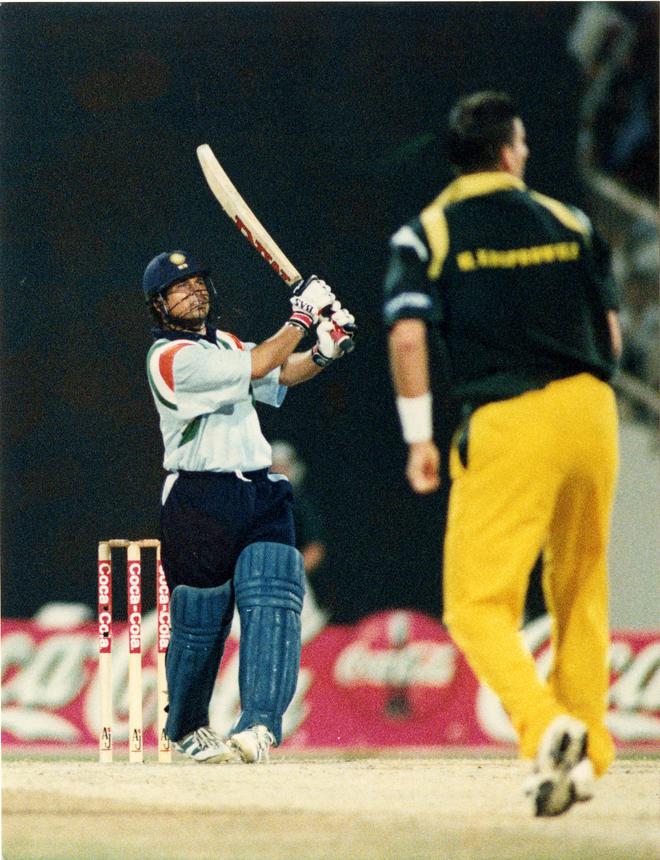
Sachin bludgeoned a star-studded Australian attack to score a breathtaking 134 in the Coca Cola Cup final in Sharjah on April 24, 1998. Two days prior, he had scored 143 against the same opposition to take India to the summit clash.
| Photo Credit: The Hindu Photo Library
So, you prefer a two-and-a-half-day Test match over a five-day dull draw?
We should not judge a Test match by the number of days it lasted but by the quality of cricket played. If the quality of cricket is good and it goes on for four-and-a-half days, I am fine. But the quality cannot be boring. Why is it that if it’s a challenging wicket, no one can bat? It is called Test cricket, that’s where your skill and character are tested. There will be difficult surfaces, and that is where you are meant to go out and show your mettle.
Taking a cue from there, what would you attribute Indian batters’ lack of form at home in Test cricket to?
Doctored pitches, lack of skills, evolving batting techniques due to limited overs’ overdose — or a culmination of all these factors? Also, whichever opposition team you take, most of their players participate in the IPL for two months. So, Indian conditions are not foreign anymore.
Similarly, for our players, they are no longer unfamiliar opponents. Earlier, if I was playing against someone, say Glenn McGrath, we would only see him every four years in Australia or every four years in India. But now, we have the luxury of spending two-and-a-half months with them every year, batting or bowling against them every day.
Yes, there have been some disappointing performances but that happens to everyone. I will not pinpoint fingers at anyone and say ‘so and so is not doing well’. I would much rather go one-on-one and tell them that this is what it is.
That is also possibly one of the reasons we have travelled better. Of course, we have the ammunition to go to any part of the world and cause problems for the opposition. It’s a combination of everything.
So is the case with the opposition. If we provide helpful tracks for bowlers, they can exploit those conditions. It cannot be just one-way traffic that our bowlers are being able to exploit, and they cannot do it.
Had T20 cricket happened earlier, would we have seen a different Sachin Tendulkar in the latter half of career?
I don’t know, honestly; tough to answer. I personally don’t think so because there was a period where several people did not understand what T20 was about and termed it as a game for youngsters without understanding it. There were a number of such experts, who hadn’t played a single ball themselves, but had larger voices than anyone else who had played for quite some time.
But I realised that it is not so taxing. In fact, I would say that T20 is the easiest format to play. In the ODIs, you have to last the whole day, which makes it the most difficult format to play physically.
T20 is not the toughest format at all. In Test cricket, when the fast bowlers have to bowl long spells in the heat, it can be very taxing. Or for that matter, if a batter has to bat the whole day under the scorching sun, that is when things can get tough.
In all these situations, of course you are going down physically but if you don’t look after your hydration or if you are not fit, the first thing that lets you down is your focus and concentration. That’s where proper fitness comes in to play.
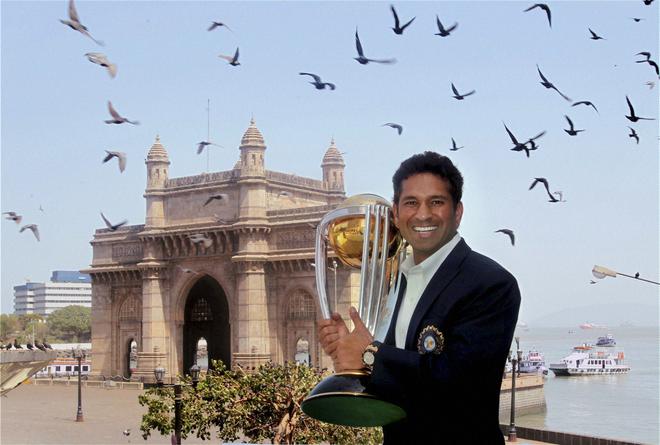
Sachin Tendulkar poses with the ODI World Cup after India’s memorable triumph at home in 2011.
| Photo Credit: PTI
Is there any period or instance during your career or life that you wish had panned out differently?
Yes, the 2007 World Cup. That phase from 2005 and 2007 wasn’t a great one in Indian cricket. Also, the late 90s, which was a dark phase in Indian cricket. These two for sure.
Late 90s also coincided with…
My captaincy!
So, when people look at your captaincy record, do you sometimes feel the other scandals are conveniently overlooked?
Without any doubt! I feel that, but I don’t want to point fingers. I think some don’t want to speak and some pretend not to know.
About India’s young cricketers, do you at times fear that they tend to be overconfident at times rather than confident?
There are two ways to look at it. One is, of course, they are getting a chance to mingle with foreign players during the IPL. Their behaviour too has changed. So, the way the teams interact with each other on and off the field pre and post-IPL is completely different.
There are also not as many rivalries as before. And for any sport, you need rivalries. Like in tennis with (Roger) Federer, (Rafael) Nadal, (Novak) Djokovic, or in Formula One with Lewis Hamilton and Max Verstappen.
Is it time to accept that we live in a world where a Mumbai Indians versus Chennai Super Kings rivalry matters more to the audience than India versus Australia?
Not the cricket audience; I am referring to the players. Crowds only respond to what the players are doing, but players don’t play according to how the crowd is responding.
There are different ways to look at it. One is the commercial interest, and the second is camaraderie between players.
If you know someone really well, then it’s a little hard to tell them what you would otherwise say on the field; you’ll be slightly measured. But if you don’t know someone, you are going to go all out and make his life uncomfortable in the middle.
So, it is also about getting to know each other. When you are familiar with each other, after spending more than two months together, then it’s different.
A career to cherish: Sachin, in the company of his family, is emotional after playing his last and 200th Test match, against the West Indies at the Wankhede Stadium in Mumbai on November 16, 2013.
| Photo Credit: The Hindu Photo Library
Speaking about young cricketers, there’s a blooming cricketer at home. How do you assess Arjun’s career shaping up?
Neither my parents nor my brother pressurised me. I got the freedom to be what I wanted to be. That’s exactly what we do with Sara and Arjun. They are not pressurised but they are asked to give their best. Whatever they are doing, whatever they wish to be in life, we ask them not to settle for the second position.
I judge them by their effort, and not the result. When you look at pushing yourself, you should look at the mirror and say: ‘This is the best I could have done’. To me, that is a winning combination. Post that, the results may not be guaranteed, but efforts are. If you tick all the boxes in that regard, I am fine.
If there’s a change that you want to see in the next decade — in India or Indian cricket — what will that be?
In cricket, I think we are heading in the right direction. The big change that I had wanted to happen — equal opportunities — has already begun with the Women’s Premier League. That too in grand style.
I was in Ahmedabad to felicitate the Under-19 girls’ team and that’s where I told Jay Shah (BCCI secretary) and Roger (Binny, BCCI president) that it’s brilliant that the WPL is being introduced. It’s going to take women’s cricket to a different level by opening the doors for so many young girls.
Somewhere you need leaders to emulate, and younger generations can watch all these women compete in a fair manner, but at a very high level.
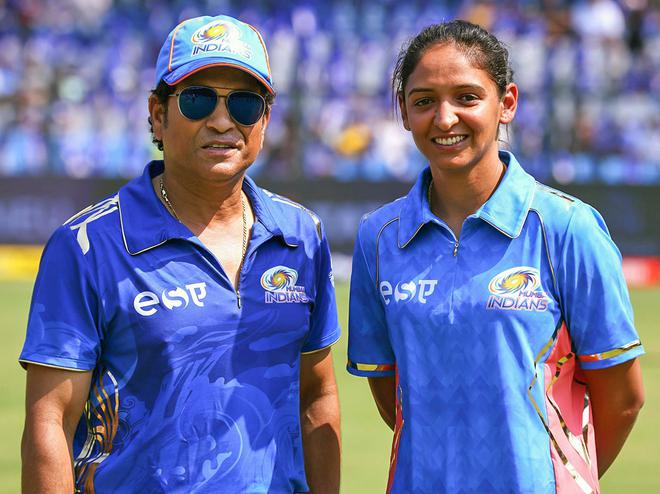
Sachin Tendulkar and Harmanpreet Kaur pose for a photo ahead of a match between Mumbai Indians and Kolkata Knight Riders at the Wankhede Stadium, in Mumbai.
| Photo Credit: ANI
Also, their athleticism was a pleasant sight to watch. I was really pleasantly surprised with the way they fielded and threw themselves on the field. I didn’t expect this level and full marks to them.
This is the change I am seeing — equality. That is what should happen not only in cricket but also in our country and beyond, plus in all professions and walks of life. Equality has multiple layers, in opportunity and freedom, to express yourself on various platforms. Being gender neutral is something that will give everyone a reason to smile.
How do you plan to remain involved with the game?
My doors are always open. As and when anyone wants to discuss anything with me and interact, I am more than happy to meet and discuss.
You have also been involved in social activities during and after your playing days. What drives you towards contributing to social development over the last decade?
We started the Sachin Tendulkar Foundation basically to work with children in three verticals — health, education and sports. We have done a decent job, which gives us satisfaction.
It’s all about what we feel from within. I have always done that right from the mid-90s but we kind of got everything together under one umbrella with more focused work.
It becomes difficult to do 25 different things, so to have just three focused verticals, that too for children, makes it feel good. Outside the Foundation, too, we do some work, but the Foundation is where my energy will be spent in my second innings.
We have a dedicated and committed team that strives to impact as many lives as possible and show them direction, channelise their energy and enthusiasm and help them achieve their dream.
We have been working all over the country with no specific region being targeted. I have received love from all over the country and it becomes my duty to give back to everyone.
Sachin in the company of Aussie legends Sir Donald Bradman and Shane Warne.
| Photo Credit: AP
Even before the Foundation was shaped, you never wasted any opportunity to interact with youngsters. How do you assess Gen Z?
The exposure they have is just unbelievable. When I was in Tadoba recently, I stopped to have a look at a school just outside a village. We used to pass a school on the way to the forest and it was as big as this room possibly — with 34 students (17 girls and 17 boys), if I am not mistaken. One of the teachers requested me to stop by, and all the children waited outside the school. It was a really special moment for me because they had a chapter on me in their books. The teacher opened the book and told the students that it was the same person. Then I interacted with them and asked them what they wanted to be. Their responses were unbelievable, be it musician, professional dancer, police officer, doctor, or scientist.
In Madhya Pradesh, too, we interacted with children. There was a school and a hostel being built, in which I had dedicated a floor to my parents. Also, in October, while we were playing a tournament, we got those kids to travel to Indore. We had arranged for about 100 of them to be taken there, and I interacted with them over there as well.
It’s good to see that the Foundation is working for them. All I can say is that if my father was alive, he would be very happy. He would have said, ‘This is the right path’, so that makes my journey even more satisfying. There is no harm in setting bigger goals, and that is something I would want to do.
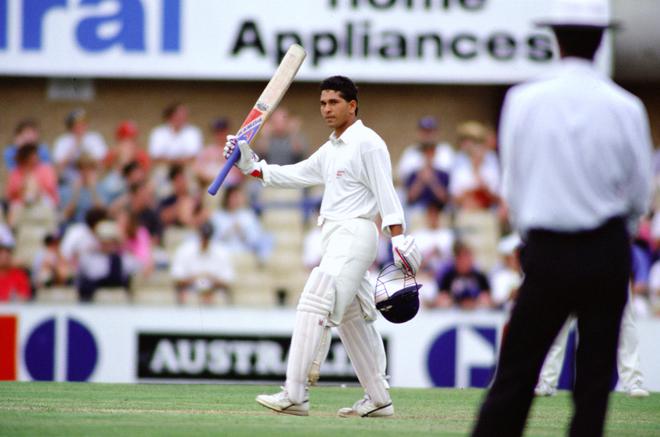
Sachin scored his first century in Australia on the fourth day of the third Test match at the Sydney Cricket Ground on January 5, 1992.
| Photo Credit: The Hindu Photo Library
At 50, is there anything that you wanted to achieve and have not been able to do yet?
Not really. The first innings lasted 24 years. In the second innings, I am just completing 10 years. Like I said, I would want to achieve more in the second innings. That’s when I would be wearing the Foundation hat and representing India. That’s my goal now.
[ad_2]

